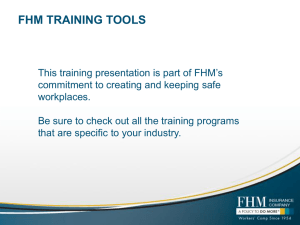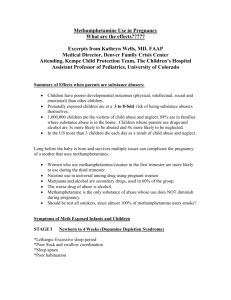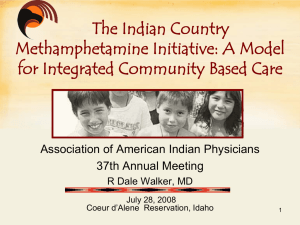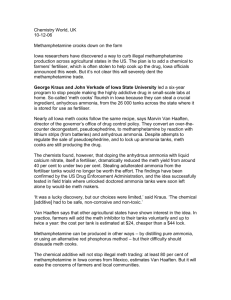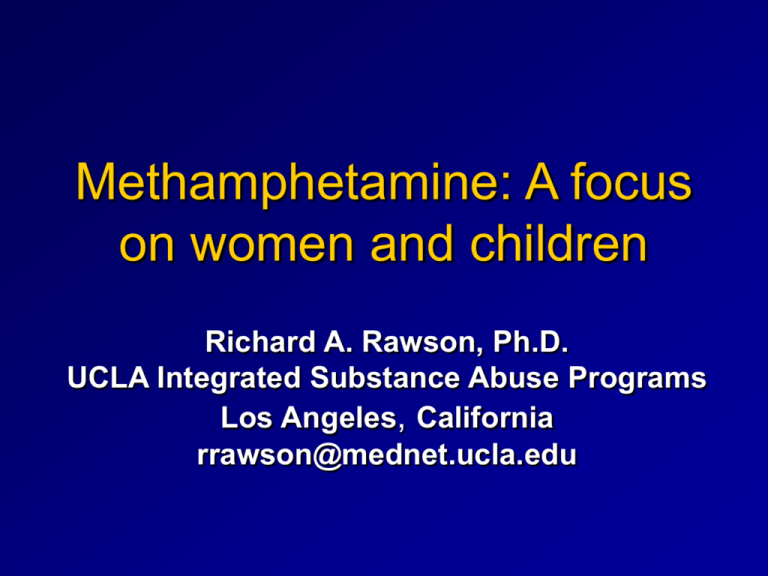
Methamphetamine: A focus
on women and children
Richard A. Rawson, Ph.D.
UCLA Integrated Substance Abuse Programs
Los Angeles, California
rrawson@mednet.ucla.edu
Speed
It is methamphetamine powder ranging in color from
white, yellow, orange, pink, or brown.
Color variations are due to differences in chemicals
used to produce it and the expertise of the cooker.
Other names: shabu, crystal, crystal meth, crank, tina,
yaba
Ice
High purity
methamphetamine
crystals or coarse
powder ranging from
translucent to white,
sometimes with a
green, blue, or pink
tinge.
Scope of the Methamphetamine
Problem Worldwide
According to surveys and estimates by WHO
and UNDCP, methamphetamine is the most
widely used illicit drug in the world except for
cannabis.
World wide it is estimated there are over 42
million regular users of methamphetamine, as
compared to approximately 15 million heroin
users and 10 million cocaine users.
IHS-Wide RPMS PCC Outpatient Encounters
for Amphetamine Related Visit by Calendar
Year
The Eastward Spread of
Methamphetamine
Methamphetamine: A Growing Menace
in Rural America
In 1998, rural areas
nationwide reported 949
methamphetamine labs.
Last year, 9,385 were
reported.
This year, 4,589 rural labs
had been reported as of
July 26.
Source: El Paso Intelligence Center (EPIC),
U.S. DEA
Stove Top Labs
The active ingredient in making
methamphetamine is ephedrine or
pseudoephedrine, commonly found in over
the counter cold remedies.
Meth Lab Seizures
A small percentage of labs seized are labeled “Super Labs” and
are capable of producing over 10 lbs per batch.
Super Labs are operated by Mexican National Drug Trafficking
Organizations (MNDTO’s), and supply the majority of meth to
the market.
Clandestine Meth Lab Equipment
Cardiovascular problems
↑ heart rate
Palpitations
Arrhythmia
↑ blood pressure
Chest Pain
– Acute Coronary
Syndrome
Valve thickening
Neurological problems
Seizures
Stroke
Cerebral
hemorrhage
Cerebral vasculitis
Mydriasis
Respiratory problems
Dyspnea
Pulmonary
hypertension
Pleuritic chest pain
Other problems
Eye ulcers
Over-heating
Rhabdomyolysis
Obstetric complications
Anorexia / weight loss
Tooth wear, cavities
“Speed bumps”
Trauma
Interpersonal
trauma
– Assault
– Gunshot
– Knife
Motor Vehicles
Suicide attempts
Methamphetamine
Acute Physical Effects
- Increases
Heart rate
Blood pressure
Pupil size
Respiration
Sensory acuity
Energy
-Decreases
Appetite
Sleep
Reaction time
Methamphetamine
Acute Psychological Effects
Increases
– Confidence
– Alertness
– Mood
– Sex drive
– Energy
– Talkativeness
Decreases
– Boredom
– Loneliness
– Timidity
Methamphetamine
Chronic Physical Effects
- Tremor
- Weakness
nose
- Dry mouth
- Weight loss
- Cough
- Sinus infection
- Sweating
- Burned lips; sore
-
Oily skin/complexion
Headaches
Diarrhea
Anorexia
Methamphetamine
Chronic Psychological Effects
-
Confusion
Concentration
Hallucinations
Fatigue
Memory loss
Insomnia
-
Irritability
Paranoia
Panic reactions
Depression
Anger
Psychosis
Methamphetamine
Psychiatric Consequences
Paranoid reactions
Permanent memory loss
Depressive reactions
Hallucinations
Psychotic reactions
Panic disorders
Rapid addiction
A Major Reason People
Take a Drug is they Like
What It Does to Their Brains
Methamphetamine abusers have
abnormal brain activity
200
% of Basal DA Output
NAc shell
150
100
Empty
50
Box Feeding
200
150
100
15
10
5
0
0
0
60
120
Time (min)
180
ScrScr
BasFemale 1 Present
Sample 1 2 3 4 5 6 7 8
Number
Scr
Scr
Female 2 Present
9 10 11 12 13 14 15 16 17
Mounts
Intromissions
Ejaculations
Source: Di Chiara et al.
Source: Fiorino and Phillips
Copulation Frequency
DA Concentration (% Baseline)
Natural Rewards Elevate Dopamine
Levels
FOOD
SEX
Accumbens
1100
1000
900
800
700
600
500
400
300
200
100
0
AMPHETAMINE
Accumbens
% of Basal Release
400
DA
DOPAC
HVA
0
1
2
3
4
250
200
100
0
5 hr
0
NICOTINE
Accumbens
Caudate
150
100
0
0
1
2
3 hr
Time After Nicotine
1
Accumbens
250
% of Basal Release
200
COCAINE
DA
DOPAC
HVA
300
Time After Amphetamine
% of Basal Release
% of Basal Release
Effects of Drugs on Dopamine Levels
2
3
4
Time After Cocaine
5 hr
MORPHINE
Dose (mg/kg)
0.5
1.0
2.5
10
200
150
100
0
0
Source: Di Chiara and Imperato
1
2
3
4
Time After Morphine
5hr
Methamphetamine Addiction
The brains of people addicted
to Methamphetamine are
different than those of
non-addicts
Cocaine and Methamphetamine Effects Compared
Cocaine
Methamphetamine
Prolonged Drug Use Changes
the Brain In Fundamental
and Long-Lasting Ways
Women and Meth
Meth and Women:
Typical gender ratio of heroin users in
treatment : 3 men to 1 woman
Typical gender ratio of cocaine users in
treatment : 2 men to 1 woman
Typical gender ratio of methamphetamine
users in treatment : 1 man to 1 woman *
*among large clinical research populations
Drug Use by Gender
90
85.1
80
70
63.7
60
50
36.3
40
30
20
14.9
10
0
Meth
Other
Males
Females
ge
th
ig
h
es
pe
ca
er
pe
pr
es
su
re
to
to
re
la
s
to
ta
x
ge
y
aw
tm
ak
or
e
e
e
ne
*t
to
o
rg
ex
re
y
pe
l
i
to
ev
rim
e
re
en
de
pl
t
ac
pr
es
e
an
si
*t
on
ot
o
he
w
or
rd
k
to
ru
m
g
co
or
e
nc
ho
en
ur
tra
s
t
e
*t
be
o
tte
lo
se
r
w
ei
gh
t
to
to
Self-Reported Reasons for Starting
Methamphetamine Use
80%
70%
60%
50%
40%
30%
20%
10%
0%
* p< .001
female
male
Self-Reported Reasons for Starting
Methamphetamine Use
40%
35%
*p< .001
Male
30%
Female
25%
20%
15%
10%
5%
0%
*to lose weight
*to relieve depression
Percent Responding
"Yes"
My sexual drive is increased by the
use of …
100
90
80
70
60
50
40
30
20
10
0
85.3
70.6
55.6
55.3
43.9
male
female
18.1 20.5
11.1
opiates
alcohol
cocaine
meth
Primary Drug of Abuse
(Rawson et al., 2002)
Percent Responding
"Yes"
My sexual pleasure is enhanced by
the use of …
100
90
80
70
60
50
40
30
20
10
0
73.5
66.7
44.7
38.2
male
female
24.4
16.0 18.2
11.1
opiates
alcohol
cocaine
meth
Primary Drug of Abuse
(Rawson et al., 2002)
Percent Responding
"Yes"
My sexual performance is improved by
the use of …
100
90
80
70
60
50
40
30
20
10
0
58.8 61.1
32.4
24.4
19.1
male
female
18.4
15.9
11.1
opiates
alcohol
cocaine
meth
Primary Drug of Abuse
(Rawson et al., 2002)
CSAT Methamphetamine Treatment Project:
Cross-Site Sample Description
1,016 clients
Average age was 32.8 years
55% female
60% Caucasian
12.2 years of education on average
16% currently married
31% awaiting charges, trial, or sentencing
Methamphetamine Use History
Avg. years of lifetime use:
7.54
Avg. days used in past 30:
11.53
Percent that usually smoked: 65%
Violence Issues in Lifetime
78% experienced violence
39% experienced sexual abuse
81% experienced one or the other
36% experienced both
Psychological Issues in Lifetime
60% depressed
56% anxiety
45% memory problems
43% violence control problems
34% suicidal thoughts
32% received medication
9% memory problems
Gender Differences in Violence
History
Female
(85%)
Male
(70%)
Partner
80%
26%
Friend
16%
38%
Other
14%
43%
(% Ever)
Gender Differences in Partner
Violence
Female
Male
Ever threatened
63%
26%
Ever Isolated
65%
37%
Ever Afraid
27%
10%
Gender Differences in Sexual
Abuse History
Female (58%)
Male
(16%)
Parent
14%
4%
Sibling
22%
6%
Partner
32%
7%
(% Ever)
Analyses reveal that a history of physical or sexual
violence (controlling for gender) is significantly
related to a number of negative outcomes.
These results suggest the importance of
understanding client background factors before
they enter treatment.
Those Who Experienced Violence Have
Fewer Years of Education and Employment
Violence
No Violence
Education
12.11
12.53
Full-Time
Employment
3.88
5.11
Those Who Experienced Violence Differ in
the Duration of Their Drug Use (Avg. Yrs.)
Violence
No Violence
7.73
6.85
Opiates
.44
.13
Sedatives
.46
.07
Marijuana
7.38
6.33
Multi-Substance
6.80
5.48
Methamphetamine
Other Drug-Related Differences
Violence
No Violence
Those Who Experienced Violence Are More Likely to Have Injected
Drugs
26%
14%
Those Who Experienced Violence Entered Drug Treatment a Greater
Number of Times
1.16
.50
Criminal Justice-Related
Differences
Violence
No Violence
Those Who Experienced Violence Spent More
Months Incarcerated
7.15
5.06
Those Who Have Experienced Violence
Have Higher Scores on the BSI and the BDI
Violence
No Violence
BSI GSI
1.01
.68
BSI PSDI
1.79
1.55
BSI PST
27.17
20.72
BDI
16.21
12.86
Those Who Have Experienced Violence
Have Higher Average Composite Scores on
the ASI
Violence
No Violence
Drug
.22
.19
Medical
.23
.14
Employment
.57
.46
Family/Social
.28
.20
Psychiatric
.25
.17
Those Who Experienced Violence Were
More Likely to Have Psychological Issues on
the ASI
Violence
No Violence
Depression
64%
44%
Anxiety
59%
44%
Violence Control
Problems
48%
27%
Suicidal Thoughts
38%
20%
Psychiatric Medication
36%
18%
Suicide Attempts
24%
12%
Other Differences
Violence
No Violence
Those Who Experienced Violence Reported Having More
Conflict With Others in Past 30 Days
3.29
1.68
Those Who Experienced Violence Entered Out-Patient
Psychiatric Treatment More Often
1.17
.45
Implications
Physical and sexual violence is related to
psychological problems and drug use pattern
differences
Different types of traumas may have different
outcomes and may affect people in different ways
A history of trauma may be related to treatment
engagement and outcome
A
nx
Pa
ie
ra
ty
no
id
Id
ea
tio
n
Ps
yc
ho
tic
is
m
Ph
ob
ic
Ho
st
ili
ty
1.40
An
xi
et
y
So
m
O
at
bs
iz
es
at
io
si
ve
n
In
Co
te
m
rp
pu
er
ls
so
iv
na
e
lS
en
si
tiv
ity
De
pr
es
si
on
Mean BSI Score
Behavior Symptom Inventory
(BSI) Scores at Baseline
1.60
all significant at p< .001
Female
1.20
Male
1.00
0.80
0.60
0.40
0.20
0.00
Beck Depression Inventory
(BDI) Scores at Baseline
20.00
p < .001
18.00
Mean BDI Score
16.00
14.00
12.00
10.00
8.00
6.00
4.00
2.00
0.00
Female
Male
Drug Endangered Children in
California: Methamphetamine
Use and Manufacture
Nena Messina, Ph.D., Patricia MarinelliCasey, Ph.D., Richard Rawson, Ph.D.
UCLA Integrated Substance Abuse
Programs
Children
Inquisitive nature of
young children makes
them more prone to
accidentally consuming
toxic chemicals that are
sometimes kept in
unmarked containers in
the refrigerator.
Children
Hundreds of children are neglected by parents
who are meth cooks. Nationally, over 20% of
the seized meth labs in 2002 had children
present.
In Washington State, the counties of Grays
Harbor, Spokane, Thurston, and Klickitat all
reported that children were found at half the labs
seized in 2002. In Lewis County, children were
found at 60-70 %, and in Clark-Skamania, 35%.
Children
Children who live in and around the area of the
meth lab become exposed to the drug and its
toxic precursors and byproducts.
80-90% of children found in homes where there
are meth labs test positive for exposure to meth.
Some are as young as 19 months old.
Children
Children can test positive for
methamphetamine by:
– Having inhaled fumes during the
manufacturing process
– Coming into direct contact with the drug
– Through second-hand smoke.
Children
Hundreds of children are neglected by parents
who are meth cooks. Nationally, over 20% of
the seized meth labs in 2002 had children
present.
In Washington State, the counties of Grays
Harbor, Spokane, Thurston, and Klickitat all
reported that children were found at half the labs
seized in 2002. In Lewis County, children were
found at 60-70 %, and in Clark-Skamania, 35%.
Children
In 2002, a total of 142 children were
present at lab seizures in Riverside and
San Bernardino Counties.
Most children reported as being present
during a seizure were school age.
Children
Children are uniquely susceptible to neurological
contamination in the environment because their
brains are still developing.
Lead poisoning is an example of what the child
is exposed to in these meth labs. A small
amount of lead that may not affect an adult can
cause neurological damage in a child.
Children are not small adults!
Different diet
Growing & developing rapidly
Higher metabolic & respiratory rate
Developing nervous system
Unusual habits (hand-to-mouth behaviors;
close to floor, contact with many surfaces, at
risk for all poisonings)
Biologic & developmental vulnerability
Drug Endangered Children Response
Teams
Why the Team Concept Is Needed
and Works...
Multi-Need Families; Multi-Need Individuals
Multi-Disciplinary Approach
Spirit of Cooperation
Sharing of Information
Case Coordination for Best Family and
Individual Outcome
DEC RESPONSE TEAM
CORE TEAM MEMBERS:
–
–
–
–
LAW ENFORCEMENT (24/7)
CHILD PROTECTIVE SERVICES (24/7)
DISTRICT ATTORNEY’S OFFICE (24/7)
MEDICAL PERSONNEL (24/7)
“AUXILIARY” TEAM MEMBERS:
– MENTAL HEALTH & THERAPEUTIC PERSONNEL
FOR CHILDREN
– ENVIRONMENTAL SERVICES, FIRE, & PUBLIC
HEALTH
– DRUG TREATMENT PROVIDERS FOR PARENTS
AND FAMILY MEMBERS
States with DEC Response Teams
DEC
Team`
`
No
DEC
DEC Resource Center, 2001
States Having Received DEC Training
from California
DEC
Training
No
Training
DEC Resource Center, 2001
Methamphetamine Treatment
Contingency Management
Matrix Model
Investigating the use of contingency
management to treat methamphetamine abuse
Contingency management is arguably the most
effective behavioral strategy for treating other
types of drug abuse.
Human laboratory investigations (Roll, Newton,
Chudzynski & Fong, under review) suggest that
methamphetamine use is amenable to
modification via the presentation of alternative
sources of reinforcement.
Combined data from several pilot studies (Roll,
Huber, et al., in press; Roll & Shoptaw, in press
All studies provided vouchers with specified
monetary values for the provision of urine
samples which indicated no recent
methamphetamine use.
Urines were collected under direct observation.
Vouchers could be exchanged for goods or
services that were congruent with developing a
drug free lifestyle.
All trials were 12 weeks in duration and
collected urine sample three times/week.
All trials had a cognitive behavioral
psychosocial platform that was
administered by trained clinicians and
delivered three times/week.
Participants 112 treatment-seeking
methamphetamine users (29 CBT and 83
CBT + Contingency Management)
mean age was 31.4 (sem 0.8) years
62.7% were Caucasian
30.1% were Hispanic
2.4% were African American
2.4% were American Indian
2.4% were Pacific Islander
44.8% were employed full time
22.9% were married
Mean number of abstinences
25
20
15
10
5
0
CM
Control
Mean weeks of consecutive abstinence
6
5
4
3
2
1
0
CM
Control
CTN 006 methamphetamine data
(Roll, et al.,in prep.)
Used the variable magnitude of
reinforcement procedure developed by
Petry.
113 methamphetamine abusing individuals
were part of the larger trial.
Received the chance to win prizes for the
provision of stimulant negative urine
samples.
Methamphetamine Outcomes from
CTN 006
16
CM (n=55)
14
Standard care (n=69)
Number of samples
12
10
8
6
4
2
0
LDA
# Negative Urine
Project Structure:
Study Sites
Billings, MT
Honolulu, HI
San Mateo, CA (2)
San Diego, CA
Concord, CA
Costa Mesa, CA
Hayward, CA
Coordinating Center
UCLA Integrated Substance Abuse Programs
Steering Committee
Scientific Advisory Board
Community Advisory Board
Baseline Demographics
Participants Served (n)
1016
Age (mean)
32.8 years
Education (mean)
12.2 years
Methamphetamine Use (mean)
7.5 years
Marijuana Use (mean)
7.2 years
Alcohol Use (mean)
7.6 years
Gender Distribution of
Participants
60
55
Percent
50
45
40
30
20
10
0
female
male
Gender
Sample Description
Ethnic Identification of
Participants
60
60
Percent
50
40
30
17
20
10
2
3
0
Ethnic Identification
18
caucasian
african amer
native amer
asian/pac isl
hispanic
Route of Methamphetamine
Administration
64
Percent Using by Route
70
60
50
40
30
20
24
11
10
0
Route of Administration
nasal
smoke
iv
Changes from Baseline
to Treatment-end
Days of Methamphetamine Use in Past
30 (ASI)
12
11.5
Mean Days Use
10
8
6
4.4
4
2
0
BL
Tx end
Possible is 0-30; tpaired=20.90; p-value<0.000 (highly sig.)
Beck Depression Inventory (BDI)
Total Scores
20
Mean Total Score
15.4
15
9.9
10
5
0
BL
Tx end
Possible is 0-63; tpaired=16.87; p-value<0.000 (highly sig.)
BSI Scores (mean)
BL1
Tx-end
Paired t *
Somatization
0.7
0.5
7.67
Obsessive-Compulsive
1.2
0.9
11.40
Interpersonal Sensitivity
1.0
0.7
11.40
Depression
1.2
0.8
11.98
Anxiety
0.9
0.6
11.24
Hostility
0.8
0.6
9.39
Phobic Anxiety
0.6
0.4
8.47
Paranoid Ideation
1.1
0.7
11.49
Psychoticism
0.9
0.6
10.70
1Possible,
all scores, is 0-4; *all p-values<0.000 (highly sig.)
Positive Symptom Total (PST) from Brief
Symptom Inventory (BSI)
Mean # symptoms
30
26
18
20
10
0
BL
Tx end
Possible is 0-53; tpaired=14.33; p-value<0.000 (highly sig.)
Matrix
TAU
12
10
8
6
4
2
0
mean number of visits
Mean Number of Weeks in Treatment
d
ra
Py
eo
at
S
nM
DA
O
Sa
eo
at
nM
Sa
o
ieg
nD
Sa
u
ul
ol
on
H
rd
wa
ay
H
a
es
M
ta
s
Co
r
co
s
ng
lli
n
Co
Bi
SITE
10
8
6
4
2
0
Matrix
TAU
ra
Py
eo
at
S
nM
DA
Sa
O
eo
at
nM
Sa
o
ieg
nD
Sa
u
ul
ol
on
H
rd
wa
ay
H
a
es
M
ta
s
Co
r
co
s
ng
lli
n
Co
Bi
d
mean number of MA-free UA's
Mean Number of UA’s that were MA-free
during treatment
SITE
Figure 4. Percent completing treatment, by group
Matrix 16
TAU
Completer
40.85
34.16
Not Completer
59.15
65.84
x2=4.68, p=0.031
Figure 6. Participant self-report of MA use (number of days during the past 30) at enrollment,
discharge, and 6-month follow-up, by treatment condition
12
11.3
11.8
Baseline
Discharge
6-month FU
meannumber of daysof MAuse
10
8
6
4.3
4.4
4.4
4
2
0
Matrix 16-wk.
TAU
4.0
Methamphetamine
Route of Administration
Percent Using by Route
Route of Methamphetamine
Administration
64
70
60
50
40
30
20
24
11
10
0
Route of Administration
intranasal (IN)
smoke (SM)
inject (IDU)
Percent
Route of Administration by Site
100%
90%
80%
70%
60%
50%
40%
30%
20%
10%
0%
oral
nasal
smoke
IV
id
am
yr A
,P S
M A
S D
, O go
M e
S Di
an lu
S olu
on rd
H wa s a
ay e
H ta M
os rd
C co
on
C s
ng
illi
B
P<.05
Craving by Route
% No Craving at baseline
70
60
50
40
30
IN
SM
IDU
20
10
0
P<.05
Drop Rates by Route
% Drop at baseline 30 days
60
50
40
30
IN
SM
IDU
20
10
0
P<.05
Length in Treatment (wks)
Treatment Length by Route
10
9
8
7
6
5
4
IN
SM
IDU
3
2
1
0
P<.05
Treatment Completion by Route
Proportion of Completion
0.7
0.6
0.5
0.4
0.3
IN
SM
IDU
0.2
0.1
0
P<.05
MA-Free Samples by Route
% of MA-free UA (3 wks)
0.7
0.6
0.5
0.4
0.3
IN
SM
IDU
0.2
0.1
0
P<.05
BSI Psychiatric Symptoms by Route
30
25
20
BL PST
TX-End PST
6-Mo PST
12-Mo PST
15
10
5
0
IN
SM
Positive Symptom Total (PST)
IDU
P<.05
Depression Scores (BDI)
Depression Symptoms by Route
20
18
16
14
12
10
8
6
4
2
0
Baseline
Tx-End
6-Month
12-Month
IN
SM
IDU
P<.05
Psychopathology and Route
IDUs > likely to have a psychiatric
disability.
IDUs > likely to have prior hospitalizations
for psychiatric problems
Methamphetamine
Methamphetamine User Tx Response
vs Cocaine User Tx Response
Medical and Psychiatric Symptoms
More MA users experienced headaches (p<.05)
and over 25% of each group experienced chest
pains.
7.7% of MA users and 5.8% of cocaine users
reported loss of consciousness during the 30 days
prior to treatment admission.
MA users appeared more disturbed and more
cognitively impaired than cocaine users.
Medical and Psychiatric Symptoms
Hallucinations were reported by one-third of MA
users and one quarter of cocaine users (p<.05).
More MA users entered treatment in a state of
severe depression (p<.05).
A small portion of both groups reported suicidal
ideation (6.9% and 2.8% respectively, p<.05).
Anecdotal reports of the clinic staff suggest that
the admission to treatment with intense paranoid
ideation was much more frequent in MA users.
Medical and Psychiatric Symptoms
MA Users %
Cocaine Users %
-Chest pain
29.8
25.5
-Headaches*
42.4
32.8
-Seizures
2.0
4.2
-Loss of consciousness
7.7
6.5
-Need medical treatment
10.7
5.8
-Depressed a lot*
19.3
12.1
-Suicidal thoughts*
6.9
2.8
-Want to injure others
17.1
14.5
-Hallucinations*
34.8
25.1
-Paranoid thoughts
28.8
25.5
Previous psychiatric treatment
14.4
16.5
Current medical problems
Current psychiatric problems
*p<.05
Treatment Length by Stimulant Users
16
14
Mean Weeks
12
10
8
6
4
2
0
Cocaine
Meth
Response to Treatment
There is no difference in the amount or type of
treatment received.
– The two groups were retained in treatment for the same
duration, and the survival curves are nearly identical.
Methamphetamine and cocaine users participated
similarly in the program.
Treatment outcomes, as measured by urine
toxicology results, does NOT vary significantly
between methamphetamine and cocaine users.
Hepatitis C by Route
80
% Prevelance
70
60
50
40
30
IN (n=1)
SM (n=6)
IDU (n=21)
20
10
0
P<.05

